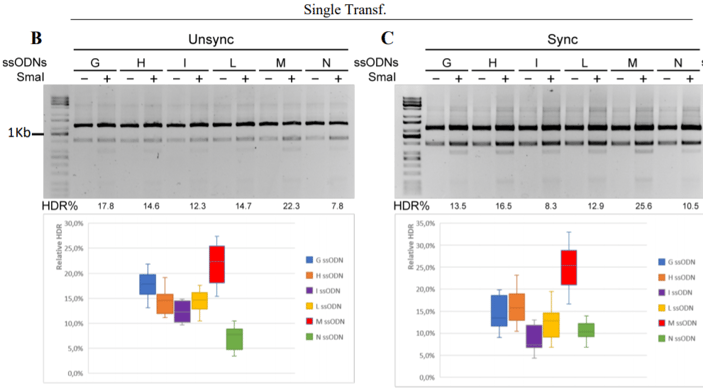Systematic analysis of factors that improve homologous direct repair (HDR) efficiency in CRISPR/Cas9 technique
Paper: PLOS ONE, March 5, 2021, M. Di Stazio et al. (Link)
The CRIPR / CAS system has been used as a tool in genetic modifications for several years. The bacterial Cas9 nuclease creates double-strand breaks in the DNA in a called PAM (proto-spacer adjacent motifs), which is a trinucleotide region repeated in the genome. With the help of synthetic RNA sequences (guide RNA), the region in the DNA can be modified in a targeted manner.
The double-strand breaks are repaired by the cell's own repair mechanisms, such as non-homologous recombination end joining (NHEJ) and homologous direct recombination (HDR). NHEJ creates random insertions or deletions in the DNA, blocking correct protein production. HDR inserts DNA sequences in the right context, whereby protein production or proteins can be modified in a targeted manner. In this case, however, the modification efficiency through homolog direct repair (HDR) is significantly lower than in the case of accidental insertion and deletion through NHEJ. The efficiency can be increased by using two sgRNA, stopping the cell cycle in G2 / M and adding ssODN (ss oligo donor), all options are tested also in combination in this publication.
In this paper the efficiency of the CRIPR / Cas9 reaction on the TNFα was investigated. TNFα regulates many biological processes, can cause diseases such as rheumatoid arthritis and is also involved in tumor development and progression.
A T7EI nuclease assay was used for efficiency analysis of the double-strand breaks. The HDR efficiency could be checked by digesting with SmaI, because a SmaI cutting region was integrated into the HDR.
For the gel analysis, the agarose was stained with Midori Green Xtra. This stain is an ultra-sensitive non-carcinogenic and non-toxic stain, which is perfect for the detection with Blue or Blue/Green LED Light. The sensitivity and acuity are as good as in gels stained with carcinogenic EtBr.
This allows the detection of very clear bands, even with weak signals. The HDR efficiency can be calculated very well from the Midori Green Xtra gels, because this dye is well suited for quantification.
